Attached files
| file | filename |
|---|---|
| 8-K - CURRENT REPORT - FIFTH THIRD BANCORP | d8k.htm |
 Fifth Third Bank | All Rights Reserved
Barclays Capital
2011 Americas Select Conference
Daniel T. Poston
Executive Vice President & Chief Financial Officer
May 24, 2011
Please refer to earnings release dated April 21, 2011 and
10-Q dated May 9, 2011 for further information
Exhibit 99.1 |
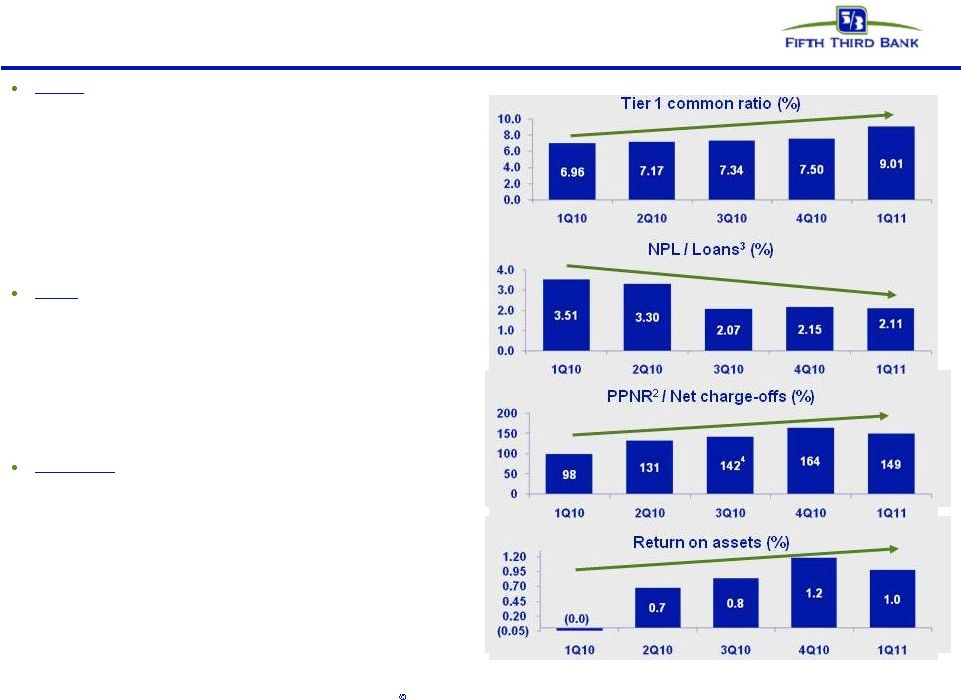 2
Fifth Third Bank | All Rights Reserved
A foundation of continued growth
Capital
–
foundation for continued growth
—
Tier 1 common capital has increased 464bps or $4.0bn¹
—
9.0% Tier 1 common ratio is $1.0bn in excess of internal ~8.0%
target
—
Capital base transformed through series of capital actions
–
$1.7bn common equity offering; $1.0bn senior notes issued;
$3.408bn TARP redemption; $280mm warrant repurchase
—
Capital levels supplemented by strong reserve levels
–
Loan loss reserves 3.62% of loans and 170% of NPLs
Credit
–
ongoing discipline driving steady improvement
—
Broad-based improvements in problem loans
–
73% reduction in 90+ day delinquent loans since 3Q09
–
NCO ratio of 1.92%, down 51% (-191 bps) since 3Q09
–
149% PPNR²
/ NCOs in 1Q11
—
Balance sheet risk lowered through asset sales, resolutions
–
$1.3bn (44%) decline in NPLs since 4Q09
Profitability
–
recent results support positive momentum
—
PPNR²
remained stable throughout cycle
—
Profitability metrics have improved significantly from crisis-era
levels, with 4 consecutive profitable quarters
—
Return on assets at or above 1.0% for last two quarters and
exceeds most peers
1
Since December 31, 2008
2
Pre-provision net revenue (PPNR): net interest income plus noninterest income
minus noninterest expense
3
Nonperforming
loans
and
leases
as
a
percent
of
portfolio
loans,
leases
and
other
assets,
including other real estate owned (excludes nonaccrual loans
held-for-sale) 4
Excluding $510mm net charge-offs attributable to credit actions and $127mm in
net BOLI settlement gains |
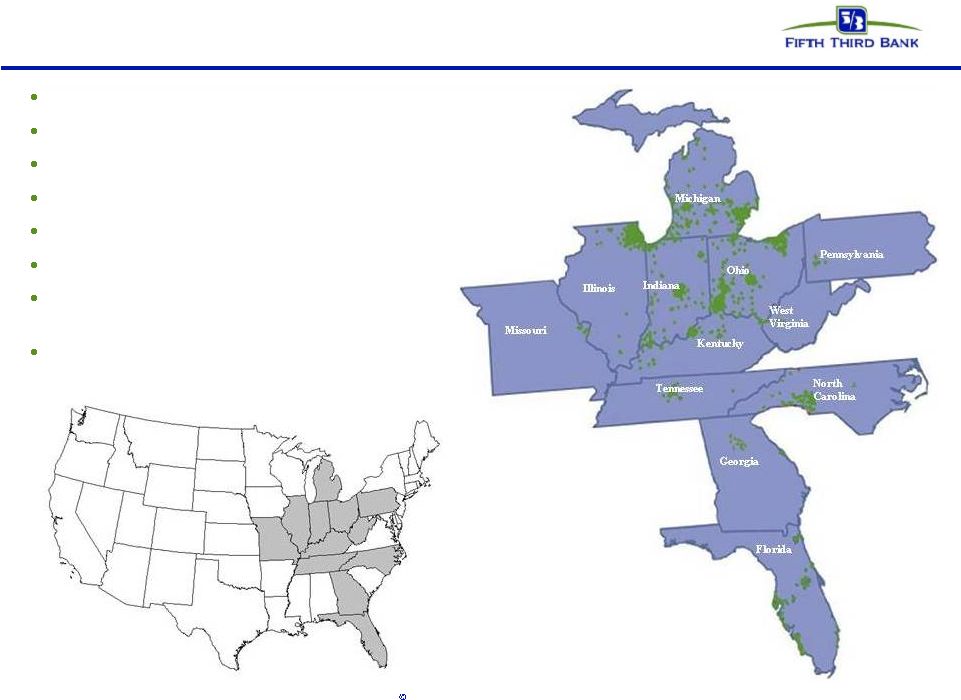 3
Fifth Third Bank | All Rights Reserved
Fifth Third franchise
$110 billion assets
$84 billion deposits
$13 billion market cap
15 affiliates in 12 states
1,310 banking centers
2,453 ATMs
Leading market share in mature Midwest
market
Built strong presence in higher growth
Southeastern markets over past 5 years |
 4
Fifth Third Bank | All Rights Reserved
1Q11 in review
Credit continuing to improve
•
Net charge-offs of $367mm (1.92% of loans and leases) vs. 4Q10
NCOs of $356mm (1.86% of loans and leases)
•
Total
NPAs
of
$2.3B
including
held-for-sale
declined
$126mm
or
5%
sequentially
to
lowest
level
since
2Q08
–
Total
delinquencies
down
12%
sequentially
(lowest
level
since 2006)
•
Provision expense of $168mm, reduction in allowance of $199mm
•
Loan loss allowance of 3.62%; coverage 132% of NPAs and 170% of
NPLs and 1.9x annualized first quarter net charge-offs
Actions driving progress
•
Focusing on credit quality, portfolio management, and loss mitigation
strategies
•
Executing on customer experience and employee engagement
initiatives
•
Enhancing breadth and profitability of offerings and relationships
•
Exit from all crisis-era government programs
Continued strong operating results
•
Net income available to common shareholders of $88mm, or $0.10 per
diluted share
–
Net income reduced by $153mm of discount accretion recorded
in preferred dividends accelerated by February repurchase of
$3.4B in TARP CPP Preferred Stock; $0.17 per share impact
•
Average loan and lease balances excluding held-for-sale up 2%
sequentially; period end loans and leases flat sequentially
•
Return on average assets of 1.0%
•
Strong capital ratios: Tier 1 common 9.0%, Tier 1 capital ratio 12.2%,
Total capital ratio 16.3% |
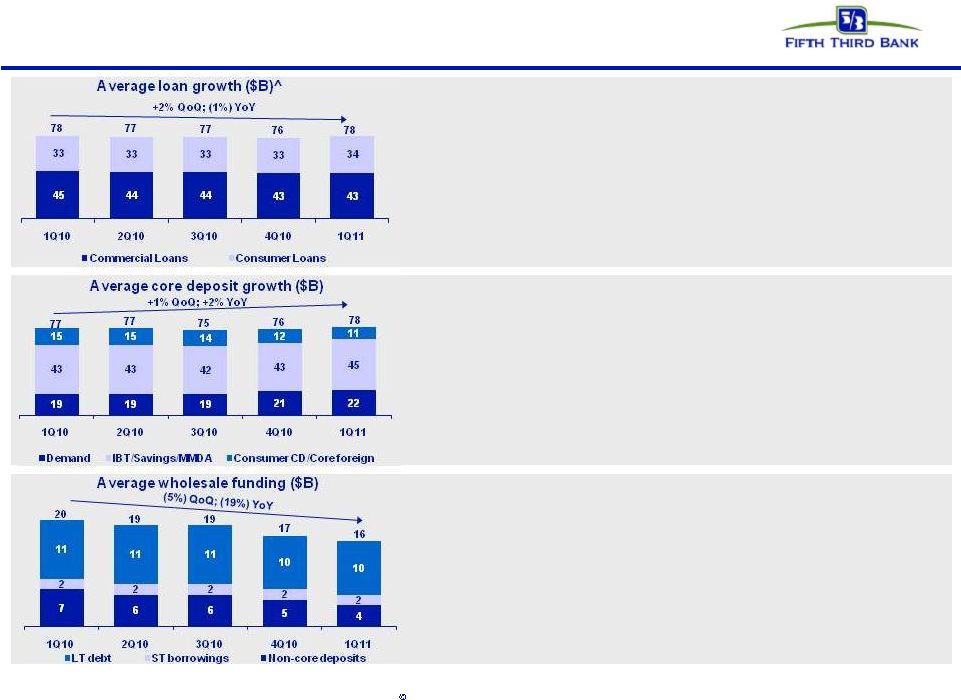 5
Fifth Third Bank | All Rights Reserved
Balance sheet
•
C&I loans up 4% sequentially and 4% from the previous year
•
CRE loans down 3% sequentially and 17% from the previous year
•
Consumer loans up 2% sequentially and 3% from the previous year
•
Warehoused residential mortgage loans held-for-sale were $1.5B at
quarter end versus $2.3B at year-end
•
Core deposit to loan ratio of 100%, up from 97% in 1Q10
•
DDAs up 2% sequentially and 15% year-over-year
•
Retail average transaction deposits up 3% sequentially and 14% from
the previous year, driven by growth in demand deposit, savings, and
interest checking account balances
•
Commercial average transaction deposits up 3% sequentially, driven by
growth in demand deposit and interest checking account balances
–
Excluding public funds balances, commercial average transaction
deposits increased 1% sequentially and 17% over prior year
•
Reduced
wholesale
funding
by
$3.8
billion
from
the
first
quarter
of
2010
–
Non-core deposits down 13% sequentially and 40% from the
previous year
–
Short term borrowings down 8% sequentially and up 16% from the
previous year
–
Long-term debt flat sequentially and down 11% from the previous
year
^ Excludes loans held-for-sale
Note: Numbers may not sum due to rounding |
 6
Fifth Third Bank | All Rights Reserved
Net interest income
•
Sequential net interest income and net interest
margin (FTE) performance driven by lower
daycount, debt issuance for TARP repayment,
lower mortgage warehouse HFS balances, 4Q10
FTPS, LLC loan refinancing, and lower yields,
partially offset by deposit mix shift and pricing as
well as higher average total loan balances
–
NII down $35mm, or 4%, sequentially and
down $17mm, or 2%, year-over-year
–
NIM down 4 bps sequentially and up 8 bps
year-over-year
•
4Q10 FTPS, LLC loan refinancing represented
nearly half of decline in C&I loan yields
* Represents purchase accounting adjustments included in net interest income.
Yield Analysis
Interest-earning assets
1Q10
4Q10
1Q11
Seq.
(bps)
YoY
(bps)
Commercial and industrial loans
4.61%
4.64%
4.45%
(19)
(16)
Commercial mortgage loans
4.20%
4.17%
4.11%
(6)
(9)
Commercial construction loans
2.92%
2.90%
3.15%
25
23
Commercial leases
4.54%
4.21%
4.17%
(4)
(37)
Residential mortgage loans
5.18%
4.64%
4.67%
3
(51)
Home equity
4.02%
3.98%
3.96%
(2)
(6)
Automobile loans
6.24%
5.41%
5.10%
(31)
(114)
Credit card
10.76%
10.55%
10.43%
(12)
(33)
Other consumer loans and leases
11.87%
18.68%
18.54%
(14)
667
Total loans and leases
4.87%
4.78%
4.67%
(11)
(20)
Taxable securities
4.28%
3.88%
3.96%
8
(32)
Tax exempt securities
3.65%
4.27%
4.77%
50
112
Other short-term investments
0.18%
0.25%
0.25%
-
7
Total interest-earning assets
4.62%
4.52%
4.47%
(5)
(15)
•
Yield on interest-earning assets declined 5 bps
sequentially and 15 bps year-over-year
Net Interest Income Reconciliation
($ in millions)
4Q10 NII (FTE)
$919
Daycount
(12)
FTPS loan restructuring
(8)
Lower mortgage warehouse
(8)
$1B debt issuance
(7)
1Q11 NII (FTE)
$884 |
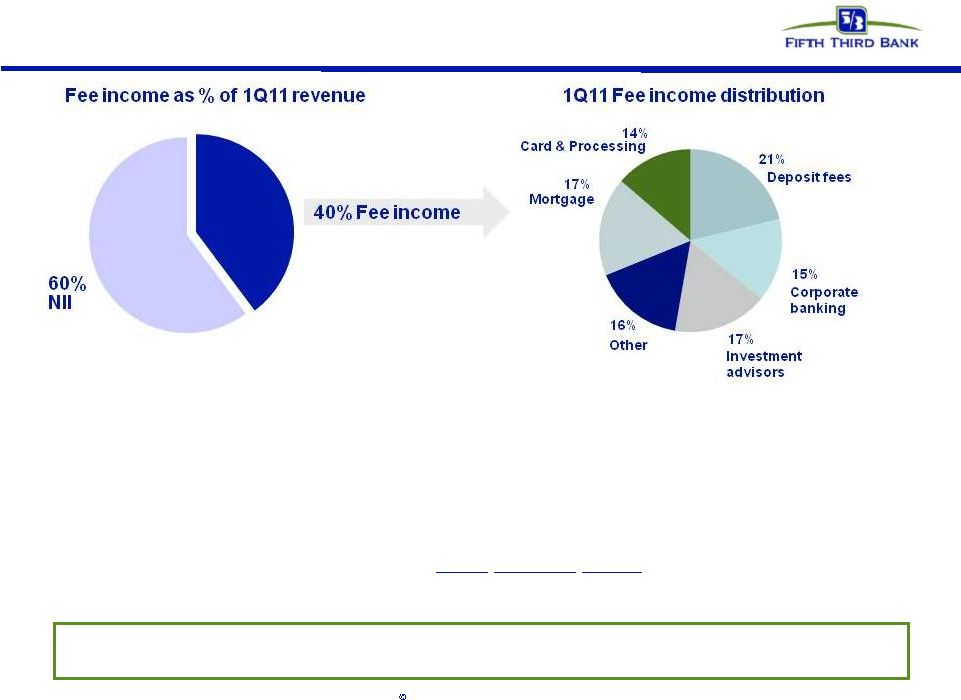 7
Fifth Third Bank | All Rights Reserved
Diverse revenue stream
•
Improving economy supportive of underlying revenue growth from loan growth and
business fee income –
Higher market interest rates in future should add further benefit
•
Negative impact of Reg E fully absorbed into results in 4Q10
•
Timing and initial impact of debit interchange legislation currently unknown
–
Legislative changes possible
–
Timing
of
implementation
2H11,
unless
timeline
altered
–
~3%
of
revenue
at
risk
from
initial
impact
before
mitigating
actions
–
Valuable
product
and
service;
expect
to
mitigate
through
adjustments
to
product
and
service
offerings
Economic trends should support long-term improvement in results through
balance sheet growth and higher business activity |
 8
Fifth Third Bank | All Rights Reserved
Strong relative credit trends
Peer average includes: BBT, CMA, HBAN, KEY, MTB, MI, PNC, RF,STI, USB, WFC, and
ZION Source: SNL Financial and company filings. NPA and NCO ratios exclude
loans held-for-sale and covered assets for peers where appropriate.
*
4Q08
NCOs
included
$800mm
in
NCOs
related
to
commercial
loans
moved
to
held-for-sale;
3Q10
NCOs
included
$510mm
in
NCOs
related
to
loans
sold
or
moved
to
held-for-sale
FITB credit metrics are now generally better than peers
|
 9
Fifth Third Bank | All Rights Reserved
Industry leading reserve levels
Source: SNL and company reports. NPAs/NPLs exclude held-for-sale portion
for all banks as well as covered assets for BBT, USB, and ZION. |
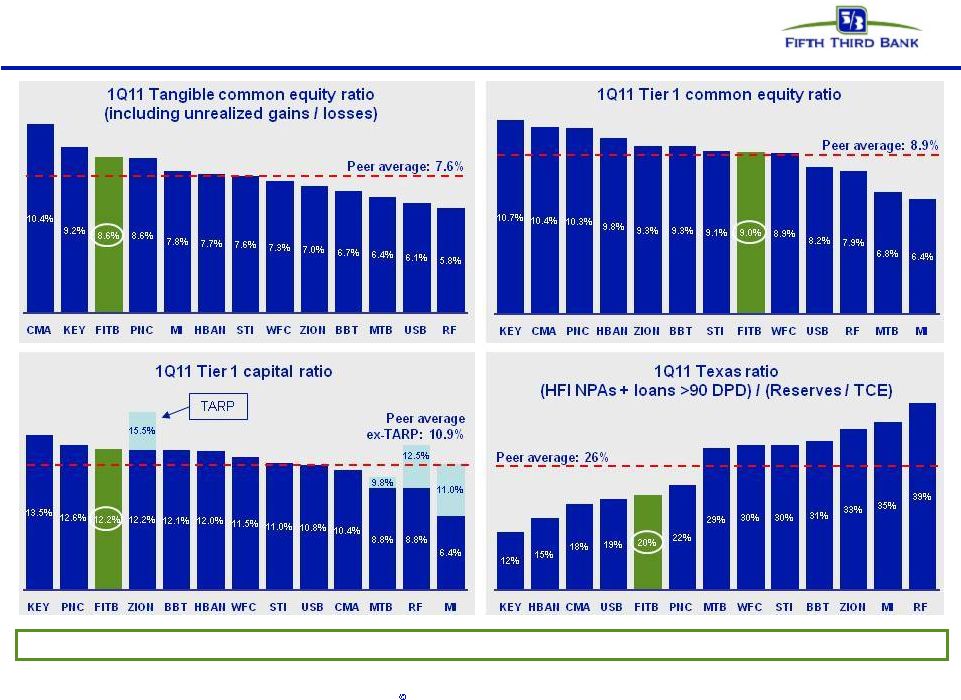 10
Fifth Third Bank | All Rights Reserved
Strong capital position
Source: SNL Financial and Company reports. HFI NPAs exclude loans
held-for-sale and also exclude covered assets for BBT, USB, and ZION
Capital ratios strong and reflect TARP CPP redemption |
 Capital management philosophy
11
FifthThird Bank | All Rights Reserved |
 12
Fifth Third Bank | All Rights Reserved
Customer-centric traditional banking model:
well-positioned for changed financial landscape
Fifth Third’s business model is driven by traditional banking activities
—
Largest bank headquartered within Fifth Third’s core Midwest footprint
—
Focus on expansion and development of businesses where regional leadership
matters –
Retail, small business, and mid-market commercial
–
Select national lines where the bank has a distinctive element (i.e., Fifth Third
Processing Solutions, Indirect Auto, Healthcare)
No
significant
business
at
Fifth
Third
impaired
during
crisis;
traditional
banking
focus
consistent with direction of financial reform
—
Didn’t / don’t originate or sell CDOs or securitize loans on behalf of
others; no mortgage securitizations outstanding (except ~$100mm HELOC from
2003) —
Didn’t / don’t originate or sell subprime mortgages or Option ARMs
—
Low level of financial system “interconnectedness”
(e.g., Fifth Third loss in Lehman
bankruptcy should be less than $2mm)
—
Little to no impact from Volcker rule (de minimis market maker in derivatives,
proprietary trading);
–
Daily VaR less than $500 thousand
–
Small private equity portfolio ~$100mm (holding company subsidiary)
Fifth Third’s businesses have performed well through the crisis -
expect reintermediation
and the landscape to evolve further toward our traditional strengths
|
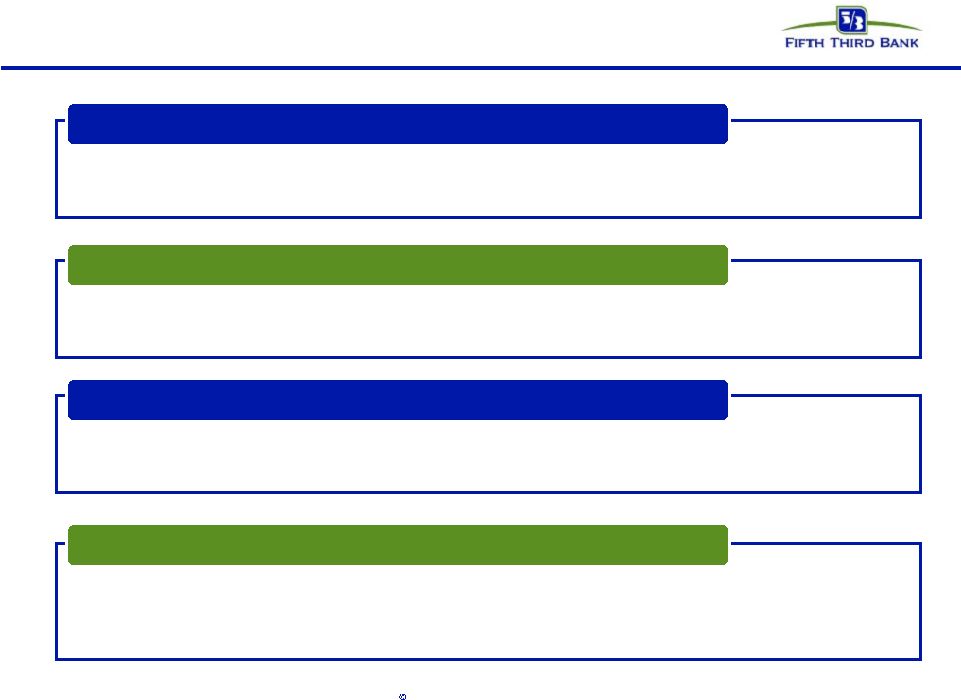 13
Fifth Third Bank | All Rights Reserved
Well-positioned for the future
•
Holding company cash currently sufficient for approximately 2 years of obligations;
no holding company or Bank debt maturities until 2013
•
Fifth Third has completely exited all crisis-era government support
programs –
Fifth Third is one of the few large banks that have no TLGP-guaranteed
debt Superior capital and liquidity position
•
NCOs below 2%; 1.9x reserves / annualized NCOs
•
$1.2B problem assets addressed through loan sales and transfer to HFS in 3Q10
•
Substantial reduction in exposure to CRE since 1Q09; relatively low CRE exposure
versus peers Proactive approach to risk management
•
Traditional commercial banking franchise built on customer-oriented localized
operating model •
Strong market share in key markets with focus on further improving density
•
Fee income ~40% of total revenues
Diversified traditional banking platform
•
PPNR has remained strong throughout the credit cycle
•
PPNR substantially exceeds annual net charge-offs (149% PPNR / NCOs in
1Q11) •
1.0% ROAA in 1Q11
Strong industry leader in earnings power |
 14
Fifth Third Bank | All Rights Reserved
Cautionary statement
This report contains statements that we believe are “forward-looking statements” within
the meaning of Section 27A of the Securities Act of 1933, as amended, and Rule 175 promulgated
thereunder, and Section 21E of the Securities Exchange Act of 1934, as amended, and Rule 3b-6 promulgated
thereunder. These statements relate to our financial condition, results of operations, plans,
objectives, future performance or business. They usually can be identified by the use of
forward-looking language such as “will likely result,” “may,” “are expected to,” “is anticipated,” “estimate,” “forecast,”
“projected,” “intends to,” or may include other similar words or phrases such as
“believes,” “plans,” “trend,” “objective,” “continue,” “remain,” or similar
expressions, or future or conditional verbs such as “will,” “would,”
“should,” “could,” “might,” “can,” or similar verbs. You should not place undue
reliance on these statements, as they are subject to risks and uncertainties, including but not
limited to the risk factors set forth in our most recent Annual Report on Form 10-K. When
considering these forward-looking statements, you should keep in mind these risks and uncertainties, as well as
any cautionary statements we may make. Moreover, you should treat these statements as speaking only as
of the date they are made and based only on information then actually known to us.
There are a number of important factors that could cause future results to differ materially
from historical performance and these forward-looking statements. Factors that might cause
such a difference include, but are not limited to: (1) general economic conditions and weakening in the
economy, specifically the real estate market, either nationally or in the states in which Fifth Third,
one or more acquired entities and/or the combined company do business, are less favorable than
expected; (2) deteriorating credit quality; (3) political developments, wars or other hostilities may
disrupt or increase volatility in securities markets or other economic conditions; (4) changes in the
interest rate environment reduce interest margins; (5) prepayment speeds, loan origination and
sale volumes, charge-offs and loan loss provisions; (6) Fifth Third’s ability to maintain required capital
levels and adequate sources of funding and liquidity; (7) maintaining capital requirements may limit
Fifth Third’s operations and potential growth; (8) changes and trends in capital markets;
(9) problems encountered by larger or similar financial institutions may adversely affect the banking industry
and/or Fifth Third (10) competitive pressures among depository institutions increase significantly;
(11) effects of critical accounting policies and judgments; (12) changes in accounting policies
or procedures as may be required by the Financial Accounting Standards Board (FASB) or other
regulatory agencies; (13) legislative or regulatory changes or actions, or significant litigation,
adversely affect Fifth Third, one or more acquired entities and/or the combined company or the
businesses in which Fifth Third, one or more acquired entities and/or the combined company are
engaged, including the recently enacted Dodd-Frank Wall Street Reform and Consumer Protection Act;
(14) ability to maintain favorable ratings from rating agencies; (15) fluctuation of Fifth
Third’s stock price; (16) ability to attract and retain key personnel; (17) ability to receive dividends from its
subsidiaries; (18) potentially dilutive effect of future acquisitions on current shareholders’
ownership of Fifth Third; (19) effects of accounting or financial results of one or more
acquired entities; (20) difficulties in separating Fifth Third Processing Solutions from Fifth Third; (21) loss of income
from any sale or potential sale of businesses that could have an adverse effect on Fifth Third’s
earnings and future growth;(22) ability to secure confidential information through the use of
computer systems and telecommunications networks; and (23) the impact of reputational risk created by
these developments on such matters as business generation and retention, funding and liquidity.
You should refer to our periodic and current reports filed with the Securities and Exchange
Commission, or “SEC,” for further information on other factors, which could cause
actual results to be significantly different from those expressed or implied by these forward-looking statements. |
